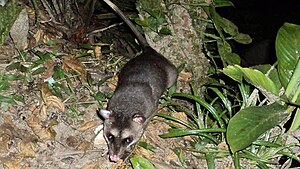Four-eye sac rats
| Four-eye sac rats | ||||||||||||
|---|---|---|---|---|---|---|---|---|---|---|---|---|

Gray four-eyed rat ( Philander opossum ) |
||||||||||||
| Systematics | ||||||||||||
|
||||||||||||
| Scientific name | ||||||||||||
| Philander | ||||||||||||
| Brisson , 1762 |
The four-eye bag rats ( Philander ) are a genus of bag mammals from the family of the opossum rats (Didelphidae). They owe their name to a light spot above each eye.
description
Four-eyed rats are outwardly mouse-like animals. Their coarse fur is gray or black on the upper side, the underside is lighter, often whitish or yellow. Its body is very slim, the muzzle pointed. The tail is equal to or longer than the body and hairless except for the first quarter. With a head body length of 25 to 33 centimeters and a weight of 200 to 700 grams (animals in captivity sometimes reach up to 1.5 kilograms), they are among the larger representatives of their family.
Distribution and way of life
These animals are widespread on the American continent , their range extends from northern Mexico to northern Argentina .
Their habitat are primarily moist, tropical forests. Primarily they live on the ground, although they are also good at climbing and even swimming. Your movements are considered fast and agile. The animals are predominantly nocturnal, although they can sometimes be observed during the day. Round nests of leaves, which they erect in the lower branches, and seldom caves in the ground, serve them as sleeping places. They are considered to be extremely aggressive, which spread with sibilants and, if necessary, fierce fighting against their enemies.
Four-eyed rats are pronounced omnivores. Their diet includes small vertebrates, eggs, insects, crabs and worms, but also fruits, leaves and seeds.
Reproduction
Females have a well-developed pouch with five to nine teats and can give birth to offspring all year round in warmer regions. After a short gestation period, the female gives birth to four to five young. These are suckled for around three months and reach sexual maturity at the age of six to eight months. Life expectancy is low at one to two years.
threat
Four-eye bag rats are widespread and are not endangered species. Occasionally they attack fields or plantations and are therefore considered a plague.
The species
In a revision of the genus published in January 2018, the following species are recognized:
- The black four-eyed rat ( Philander andersoni ) occurs in the northwestern Amazon basin.
- Philander canus (Osgood, 1913), a species widespread in tropical South America, which was previously considered a synonym or subspecies of the four-eyed rat.
- McIlhenny's four-eyed rat ( Philander mcilhennyi ) from the western Amazon basin.
- Philander melanurus (Thomas, 1899), from Panama and Colombia and Ecuador west of the Andes.
- Gray four-eyed rat ( Philander opossum ) from the eastern Amazon basin.
- Philander pallidus (Allen, 1901), from Central America (Yucatan, Belize, El Salvador).
- The pebas four- eyed rat ( Philander pebas ), a species newly described in early 2018 that is endemic to the Amazon basin.
- The southeastern four- eyed rat ( Philander quica ) is endemic to the Atlantic rainforest .
No statement could be made about the validity of two other described species because no DNA samples were available. These are the Orinoco Delta four- eyed opossum ( Philander deltae ) and Philander nigratus . Both could also be valid types.
The naked tail pouch rat is sometimes referred to as the brown four-eye pouch rat, but it has only superficial similarities to this genus and is not closely related to it.
literature
- Nowak, Ronald M .: Walker's Mammals of the World . Johns Hopkins University Press, 1999 ISBN 0-8018-5789-9
supporting documents
- ^ Robert S. Voss, Juan F. Díaz-Nieto and Sharon A. Jansa. 2018. A Revision of Philander (Marsupialia: Didelphidae), Part 1: P. quica, P. canus, and A New Species from Amazonia. American Museum Novitates. Number 3891; 1-70. DOI: 10.1206 / 3891.1